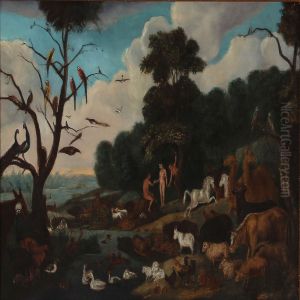Gijsbert De Hondecoeter Paintings
Gijsbert Gillesz. de Hondecoeter, born in 1604 in Utrecht, Netherlands, was a Dutch painter renowned for his contributions to the Baroque period, particularly in the realm of bird and landscape paintings. Hailing from a family of artists, Gijsbert was the son of Gilles de Hondecoeter and the grandson of landscape painter Gillis d'Hondecoeter. His family background laid a solid foundation for his artistic journey, immersing him in an environment that valued and nurtured his talents from an early age.
De Hondecoeter's work is characterized by meticulous attention to detail and a profound appreciation for the natural world, attributes that distinguished him within the Dutch Golden Age of painting. Early in his career, Gijsbert moved to Amsterdam, where he became an influential figure in the city's vibrant artistic community. His paintings often depicted domestic and exotic birds within idyllic garden or landscape settings, capturing the essence of these creatures with remarkable realism and sensitivity.
Throughout his career, De Hondecoeter's ability to blend realism with an idealized vision of nature won him the admiration of his contemporaries and wealthy patrons alike. His compositions are notable for their dynamic arrangement and the skillful use of lighting, which he employed to highlight the textures and colors of feathers and foliage, creating scenes that are both engaging and serene.
Gijsbert De Hondecoeter's legacy is marked by his contribution to the development of bird painting as a genre in the Netherlands. He inspired subsequent generations of artists, including his more famous nephew, Melchior d'Hondecoeter, who would go on to achieve greater renown for his own bird paintings. Gijsbert's death in 1653 in Amsterdam marked the end of a career that had a lasting impact on Dutch art, leaving behind a body of work that continues to be celebrated for its beauty and technical mastery.
